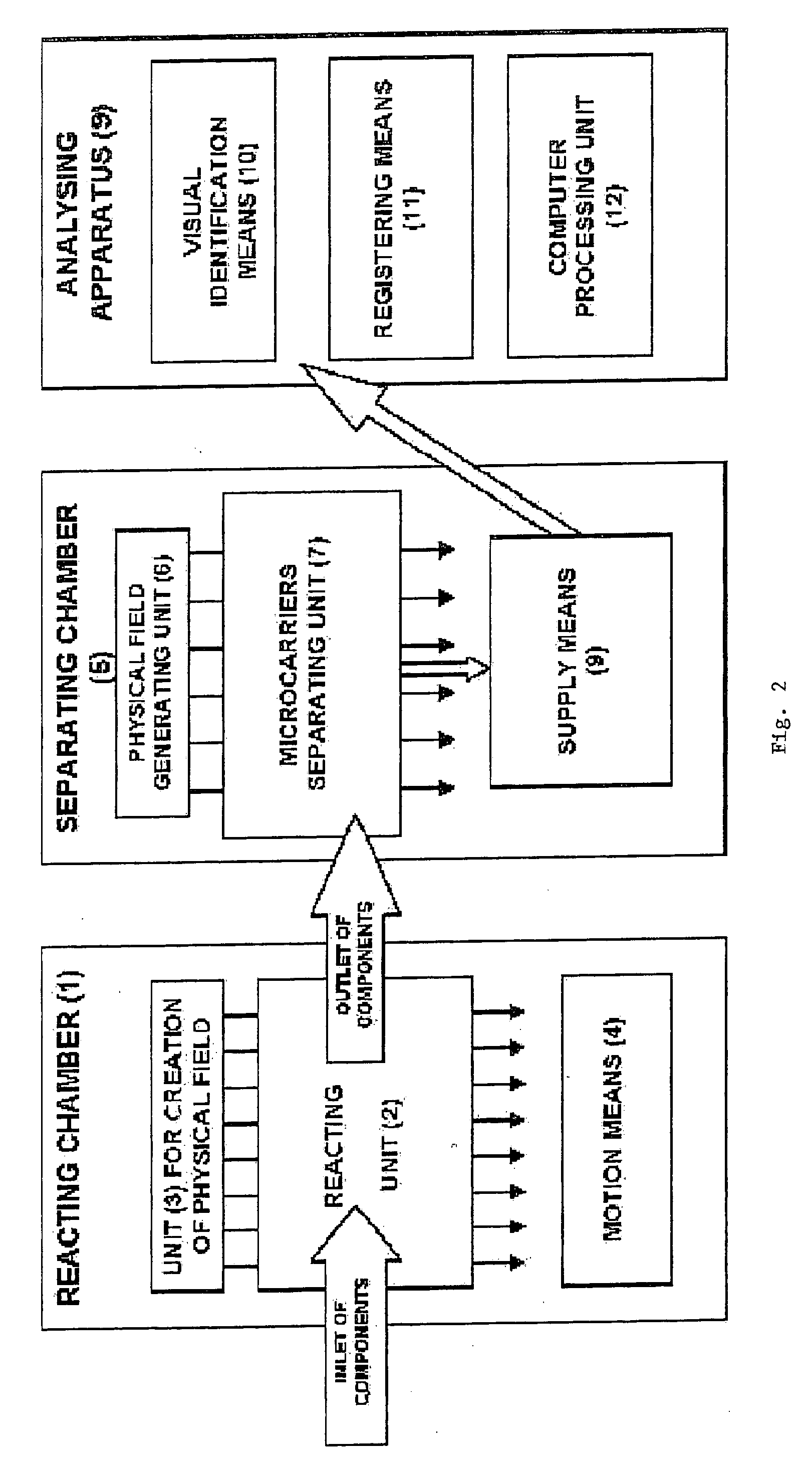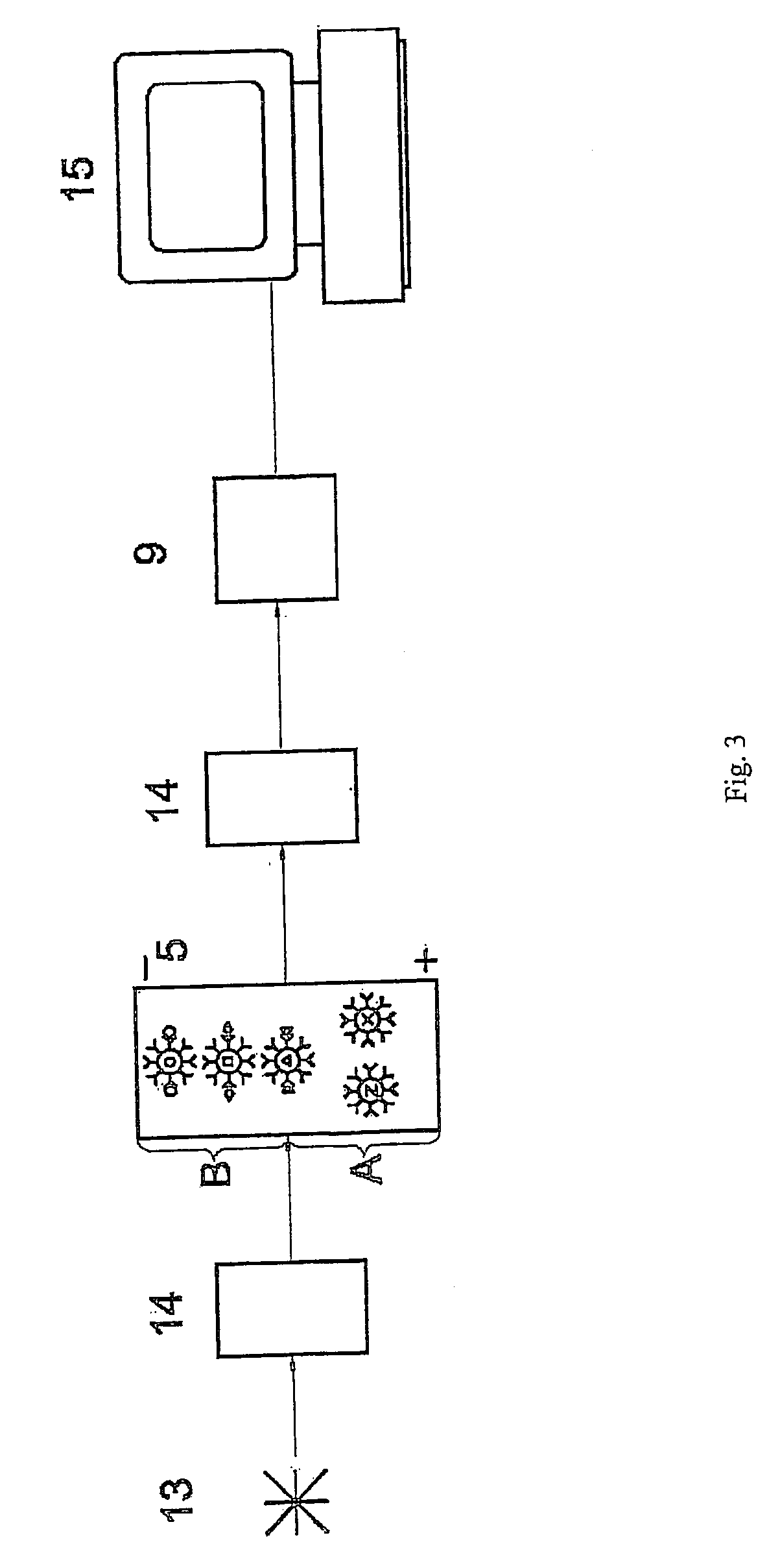Method and device for simultaneous detection of multiple components in a mixture
a technology of multiple components and detection methods, applied in the field of simultaneous detection of multiple components in a mixture, can solve the problems of low sensitivity, limited amount of components analyzed simultaneously, and the inability to reliably define the lack of an individual, etc., and achieve the effect of low sensitivity
- Summary
- Abstract
- Description
- Claims
- Application Information
AI Technical Summary
Benefits of technology
Problems solved by technology
Method used
Image
Examples
example 1
[0094] FIG.3 shows a principal diagram of a device filed for implementation of one of the versions of a method filed. An ultraviolet radiation source 13, optical filters 14 and analyzing means 9 which is a fluorescence detector are installed on an optical axis together with separating chamber 5 in the form of a capillary electrophoresis apparatus (not shown at the drawings). Active fluorescent dyes No. 33258, No. 33276, No. 33285, No. 33514 and No. 33258 with absorption and emission spectra shown in FIG. 4 were used for encapsulation of microcarriers with the spheres made of chitin having the dimensions of 2 mkm. Each type of marked microcarriers thus obtained was combined with monoclonal antibodies for the following human's blood serum proteins (albumin, transferrin, fibrinogen, cerulloplasmin and .alpha. 2-microglobulin) by means of reaction with carbodiimide. The complexes thus obtained were fractionated in an electric field in a capillary electrophoresis apparatus with an electr...
example 2
[0095] Microcarriers in the shape of needle crystals having the dimensions of 3.times.0,2 mkm made of synthetic zeolites of H-6, K-4, M-8 and KO-4 brand were covered by a thin layer of dibutyrilchitin with the fragments of pollen of the following cereals added to it, i.e. rye, wheat, oats and fowl distinguished by their characteristic shape and visible light polarization. Each type of marked zeolite was pre-fractionated in an electric field of a capillary electrophoresis apparatus with an electric field intensity of 30 V / cm in 0,1 M Tris-glycine buffer pH 8,3. Fractions with identical mobility were combined in a test system to provide equal proportions of each zeolite in a mixture.
[0096] The mixture under analysis of K, Na, Cu and Co cations in the form of 0,1 mkM solutions in the amount of 0,2 ml was added to the test system, and re-separation was carried out in a capillary electrophoresis device with an electric field intensity of 30 V / cm in 0,1 M Tris-glycine buffer pH 8,3. Fract...
example 3
[0097] The suspension of bacteria Magnetospirilla grphiswaldense with the dimensions of 42.times.5 mkm was mixed with a 6% water solution of polyvinyl alcohol, and a 1% water solution of glutaraldehyde was added at intensive stirring. After washing out of non-reacted components and water-soluble reaction products the particles thus received were chemically bound with active fluorescent dyes N 33258, N 33276, N 33285, N 33514 and N 33258 with absorption and emission spectra of said dyes shown in FIG. 4. Each type of marked magnetically responsive microcarriers was bound with avidin molecules by means of tosylation. Biotinilated monoclonal antibodies were bound to the following human blood serum proteins such as albumin, transferrin, fibrinogen, cerulloplasmin and .alpha.-2-microglobulin by means of incubation of each type of antibodies with microcarriers marked with a definite dye. The complexes thus obtained were pre-fractionated in an CTV (cell tracking velocimetry) apparatus for d...
PUM
 Login to View More
Login to View More Abstract
Description
Claims
Application Information
 Login to View More
Login to View More - R&D
- Intellectual Property
- Life Sciences
- Materials
- Tech Scout
- Unparalleled Data Quality
- Higher Quality Content
- 60% Fewer Hallucinations
Browse by: Latest US Patents, China's latest patents, Technical Efficacy Thesaurus, Application Domain, Technology Topic, Popular Technical Reports.
© 2025 PatSnap. All rights reserved.Legal|Privacy policy|Modern Slavery Act Transparency Statement|Sitemap|About US| Contact US: help@patsnap.com



